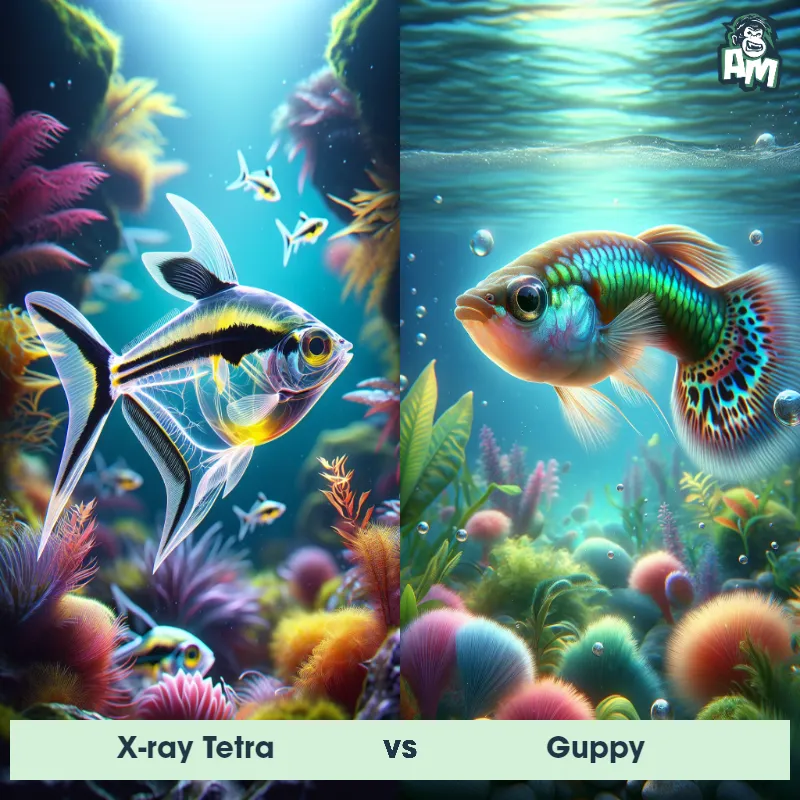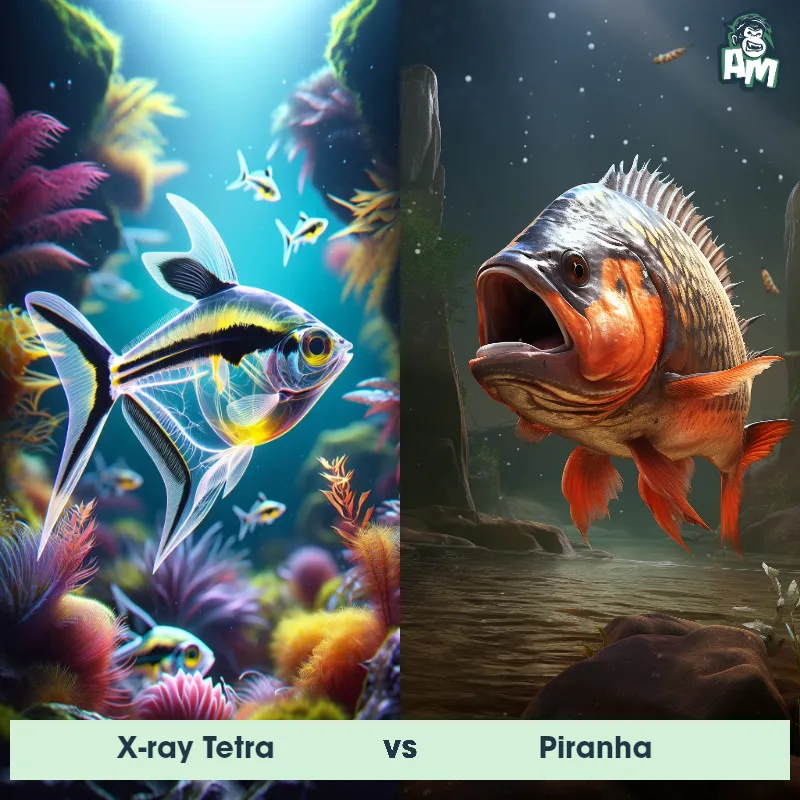The X-ray Tetra
The X-ray Tetra, also known as Pristella maxillaris, is a small freshwater fish belonging to the family Characidae. It is native to South America, specifically the Amazon River Basin. This tetra species has a unique appearance with a transparent body that allows you to see its internal organs, hence its name. The X-ray Tetra has a sleek, elongated body with a silver coloration and a black horizontal stripe that runs from its nose to the caudal fin. It possesses small, vibrant red fins that add a pop of color to its overall look. These peaceful and active fish are primarily found in densely vegetated habitats, where they can hide and feel secure.

| X-ray Tetra | |
|---|---|
| Size | Up to 2 inches (5 centimeters) |
| Weight | Lightweight, less than 1 ounce (28 grams) |
| Speed | 1.5 mph (2.4 km/h) |
| Key Strength | Agility and shoaling behavior |
| Biggest Weakness | Small size and lack of aggressive defense mechanisms |
| Scientific Name | Pristella maxillaris |
| Family | Characidae |
| Habitat | Freshwater |
| Geography | South America (Amazon Basin and Orinoco Basin) |
| Diet | Omnivorous, feeds on small insects, crustaceans, and plant matter |
| Lifespan | 2 years - 5 years |

The X-ray Tetra
The X-ray Tetra, also known as Pristella maxillaris, is a small freshwater fish belonging to the family Characidae. It is native to South America, specifically the Amazon River Basin. This tetra species has a unique appearance with a transparent body that allows you to see its internal organs, hence its name. The X-ray Tetra has a sleek, elongated body with a silver coloration and a black horizontal stripe that runs from its nose to the caudal fin. It possesses small, vibrant red fins that add a pop of color to its overall look. These peaceful and active fish are primarily found in densely vegetated habitats, where they can hide and feel secure.
Fun Fact: The X-ray Tetra has a remarkable ability to change the color of its dorsal and anal fins, which can transform from red to bright white when the fish is startled or feels threatened, serving as a visual signal to potential predators.
| X-ray Tetra | |
|---|---|
| Size | Up to 2 inches (5 centimeters) |
| Weight | Lightweight, less than 1 ounce (28 grams) |
| Speed | 1.5 mph (2.4 km/h) |
| Key Strength | Agility and shoaling behavior |
| Biggest Weakness | Small size and lack of aggressive defense mechanisms |
| Scientific Name | Pristella maxillaris |
| Family | Characidae |
| Habitat | Freshwater |
| Geography | South America (Amazon Basin and Orinoco Basin) |
| Diet | Omnivorous, feeds on small insects, crustaceans, and plant matter |
| Lifespan | 2 years - 5 years |
X-ray Tetra Matchups
We use AI to simulate matchups between the X-ray Tetra and other animals. Our simulation considers size, strength, and natural predatory behaviors to determine the most likely outcome.
X-ray Tetra: Diet, Predators, Aggression, and Defensive Behaviors
What do X-ray Tetras eat?
X-ray Tetras are omnivorous and primarily feed on small insects, worms, and crustaceans in the wild. In captivity, they can also be fed commercially-prepared fish flakes, bloodworms, and brine shrimp.
Do X-ray Tetras have any predators?
Yes, X-ray Tetras are small fish that are often preyed upon by larger fish, birds, and other aquatic animals in their natural habitat. Common predators include larger fish species and birds that feed on small fish.
Are X-ray Tetras aggressive?
X-ray Tetras are generally peaceful and non-aggressive fish. They are known for their calm and social behavior, making them suitable for community aquariums with other peaceful fish species of similar size.
Do X-ray Tetras fight amongst themselves?
X-ray Tetras may exhibit some aggression towards each other, especially during feeding times or when establishing dominance within a group. However, these fights are usually minor and do not result in serious injuries.
How do X-ray Tetras defend themselves?
X-ray Tetras have several defense mechanisms to protect themselves from predators, including their small size and speed. They are also known to swim in schools, which helps to confuse predators and increases their chances of survival.
What is the biggest weakness of X-ray Tetras in a fight?
The small size of X-ray Tetras is their biggest weakness in a fight, as they may be easily overpowered by larger and more aggressive fish. Their peaceful nature and lack of strong defensive capabilities also make them vulnerable in confrontations with dominant fish species.
Fun Fact: X-ray Tetras are known for their schooling behavior, as they prefer to live in groups of at least six individuals. This schooling behavior provides them with protection against predators, enhances their foraging efficiency, and helps them to communicate and coordinate their movements.
Fun Fact: X-ray Tetras are omnivorous, feeding on a variety of small organisms in their natural habitat. They have a knack for surface feeding, often leaping from the water to snatch insects or small flies that stray too close to the surface, displaying impressive acrobatic skills.













